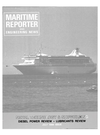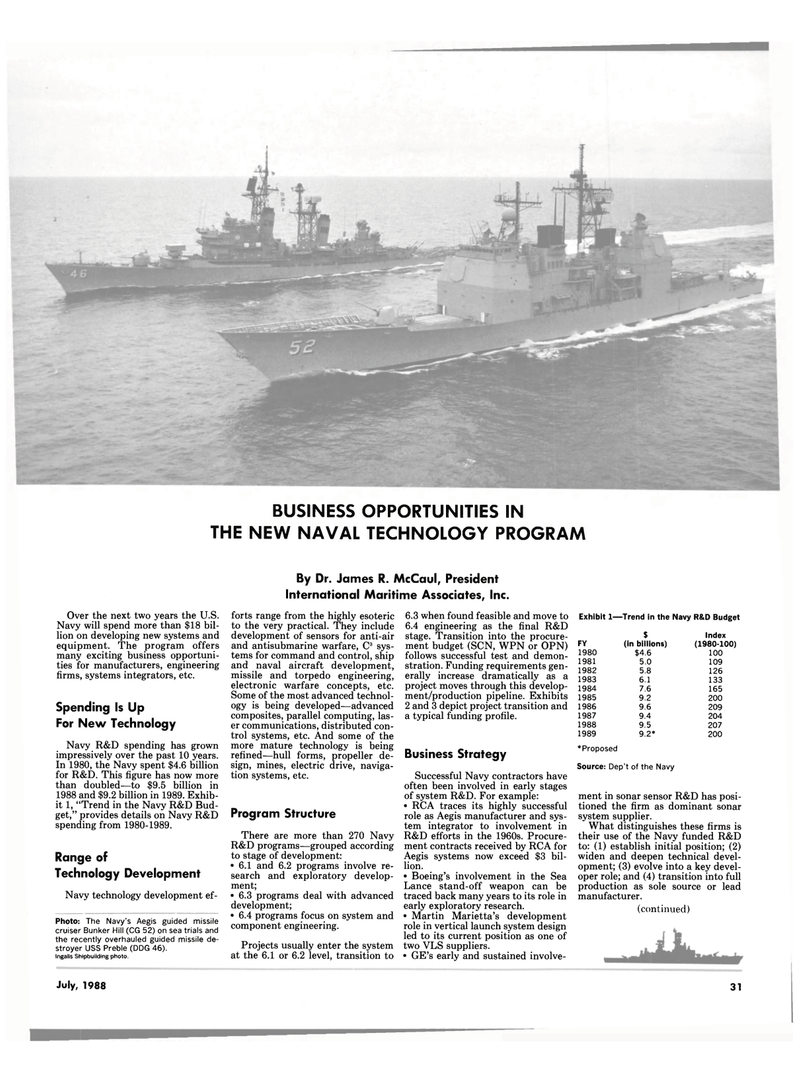
Page 23: of Maritime Reporter Magazine (July 1988)
Read this page in Pdf, Flash or Html5 edition of July 1988 Maritime Reporter Magazine
BUSINESS OPPORTUNITIES IN
THE NEW NAVAL TECHNOLOGY PROGRAM
By Dr. James R. McCaul, President
International Maritime Associates, Inc.
Over the next two years the U.S.
Navy will spend more than $18 bil- lion on developing new systems and equipment. The program offers many exciting business opportuni- ties for manufacturers, engineering firms, systems integrators, etc.
Spending Is Up
For New Technology
Navy R&D spending has grown impressively over the past 10 years.
In 1980, the Navy spent $4.6 billion for R&D. This figure has now more than doubled—to $9.5 billion in 1988 and $9.2 billion in 1989. Exhib- it 1, "Trend in the Navy R&D Bud- get," provides details on Navy R&D spending from 1980-1989.
Range of
Technology Development
Navy technology development ef-
Photo: The Navy's Aegis guided missile cruiser Bunker Hill (CG 52) on sea trials and the recently overhauled guided missile de- stroyer USS Preble (DDG 46).
Ingalls Shipbuilding photo. forts range from the highly esoteric to the very practical. They include development of sensors for anti-air and antisubmarine warfare, C3 sys- tems for command and control, ship and naval aircraft development, missile and torpedo engineering, electronic warfare concepts, etc.
Some of the most advanced technol- ogy is being developed—advanced composites, parallel computing, las- er communications, distributed con- trol systems, etc. And some of the more mature technology is being refined—hull forms, propeller de- sign, mines, electric drive, naviga- tion systems, etc.
Program Structure
There are more than 270 Navy
R&D programs—grouped according to stage of development: • 6.1 and 6.2 programs involve re- search and exploratory develop- ment; • 6.3 programs deal with advanced development; • 6.4 programs focus on system and component engineering.
Projects usually enter the system at the 6.1 or 6.2 level, transition to 6.3 when found feasible and move to 6.4 engineering as the final R&D stage. Transition into the procure- ment budget (SCN, WPN or OPN) follows successful test and demon- stration. Funding requirements gen- erally increase dramatically as a project moves through this develop- ment/production pipeline. Exhibits 2 and 3 depict project transition and a typical funding profile.
Business Strategy
Successful Navy contractors have often been involved in early stages of system R&D. For example: • RCA traces its highly successful role as Aegis manufacturer and sys- tem integrator to involvement in
R&D efforts in the 1960s. Procure- ment contracts received by RCA for
Aegis systems now exceed $3 bil- lion. • Boeing's involvement in the Sea
Lance stand-off weapon can be traced back many years to its role in early exploratory research. • Martin Marietta's development role in vertical launch system design led to its current position as one of two VLS suppliers. • GE's early and sustained involve-
Exhibit 1—Trend in the Navy R&D Budget $ Index
FY (in billions) (1980-100) 1980 $4.6 100 1981 5.0 109 1982 5.8 126 1983 6.1 133 1984 7.6 165 1985 9.2 200 1986 9.6 209 1987 9.4 204 1988 9.5 207 1989 9.2* 200 "Proposed
Source: Dep't of the Navy ment in sonar sensor R&D has posi- tioned the firm as dominant sonar system supplier.
What distinguishes these firms is their use of the Navy funded R&D to: (1) establish initial position; (2) widen and deepen technical devel- opment; (3) evolve into a key devel- oper role; and (4) transition into full production as sole source or lead manufacturer. (continued)
July, 1988 31

 22
22

 24
24
